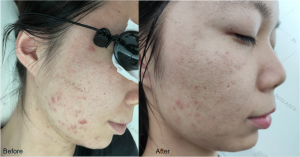Acne, commonly known as "acne", is a chronic inflammatory skin disease that occurs in the hair follicles and sebaceous glands. Acne can lead to post-inflammatory hyperpigmentation, erythema (pockmarks), and permanent scarring (acne scars), with severe psychological and social impacts.
According to the nature and severity of acne lesions, acne can be divided into three grades and four grades:
Grade I (mild): only comedones;
Grade II (moderate): In addition to acne, there are a few inflammatory papules and pustules;
Grade III (moderate): In addition to acne, there are many inflammatory papules and pustules;
Grade IV (severe): In addition to acne, inflammatory papules and pustules, there are nodules, cysts, and even scars.
After a lot of clinical practice, it has been proved that SUSLASER photodynamic therapy is a safe and effective photochemical therapy method. It can directly and effectively kill the main pathogenic bacteria of acne: Propionibacterium acnes; can effectively inhibit the secretion function of sebaceous glands, reduce the oiliness of the skin; is a good curative effect.
Photodynamic therapy is a technology based on the interaction of light, photosensitizers and oxygen using photochemical reactions. The photosensitizer is applied locally to the skin lesions and encapsulated. After a certain period of time, the photosensitizer will undergo a rapid photochemical reaction to generate highly active singlet oxygen, which will undergo oxidation reactions with adjacent biological macromolecules. It produces cytotoxic effects, which in turn lead to the damage and death of Propionibacterium acnes and sebaceous gland cells, so as to achieve the purpose of treatment.
What kind of person is suitable for photodynamics?
1. Patients with moderate-to-severe acne who have not responded to traditional treatments
2. Severe acne patients who are prone to scarring and cause cosmetic problems
3. Acne patients who are unwilling or unsuitable for antibiotic treatment
4. Acne patients who cannot tolerate the stimulation of topical drugs
5. Acne patients who cannot tolerate the side effects of oral medications
How should I care after treatment? How safe is the treatment?
◆For 2-3 days after treatment, avoid the exposure of strong ultraviolet rays outdoors and strong light indoors.
◆Slight flushing and edema may appear in the treatment area 1-2 days after treatment, which is normal and generally does not need to be treated.
◆In the early stage of treatment, some patients may have transient acne worsening, or even pus, which is a normal response to treatment. Most patients can be relieved within 1-2 weeks, and should not be squeezed by themselves; if symptoms worsen, seek medical attention in time , Do not deal with it privately.
◆Dry skin, scaling and redness may appear after treatment, which are normal treatment reactions. Mild skin care products can be used to relieve symptoms under the guidance of a doctor.
◆Pigmentation may appear after treatment, but it will subside after a certain period of time.
◆Be sure to pay attention to sun protection during the course of treatment. You can choose to use physical sunscreen and sunscreen hat.
Post time: Aug-15-2022






